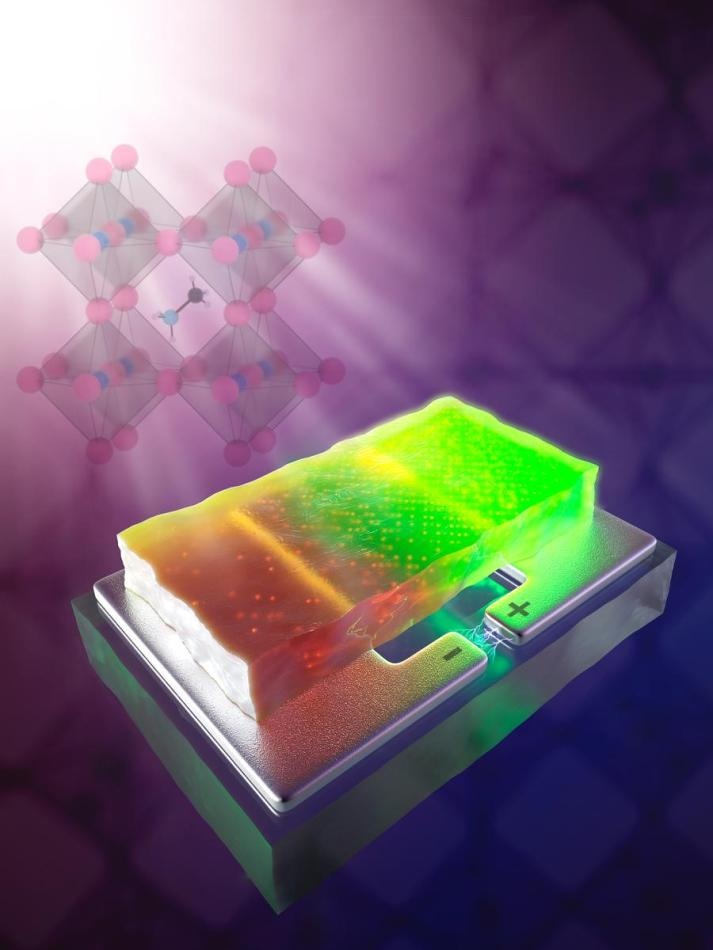Nov 22 2017
A group of researchers led by the University of California San Diego have for the first time detected nanoscale variations deep within hybrid perovskite crystals that could offer new understandings into developing economical and high-efficient solar cells.
 The inside back cover image of the Nov. 20, 2017 issue of Advanced Materials illustrates how ion migration in a hybrid perovskite crystal affects solar cell performance in different areas of the crystal. Image credit: AMOLF.
The inside back cover image of the Nov. 20, 2017 issue of Advanced Materials illustrates how ion migration in a hybrid perovskite crystal affects solar cell performance in different areas of the crystal. Image credit: AMOLF.
Using X-ray lasers and beams, researchers examined how a new favorable class of solar cell materials, called hybrid perovskites, acts at the nanoscale level while in operation. Their experiments exposed that when voltage is applied, ions travel within the material, forming regions that are no longer as efficient at changing light to electricity.
Ion migration hurts the performance of the light absorbing material. Limiting it could be a key to improving the quality of these solar cells.
David Fenning, Professor of Nanoengineering and Member of the Sustainable Power and Energy Center, UC San Diego
The team, headed by Fenning, includes researchers from the AMOLF Institute in the Netherlands and Argonne National Laboratory. Researchers published their work in Advanced Materials.
Hybrid perovskites are crystalline materials composed of a blend of both organic and inorganic ions. They are potential materials for creating next-generation solar cells because they are economical to manufacture and are largely efficient at converting light to electricity.
However, hybrid perovskites are not highly stable, which can make them hard to explore. Microscopic methods usually used to examine solar cells frequently end up damaging the hybrid perovskites or cannot image beyond their surfaces.
Currently, a UC San Diego-led team has demonstrated that by using a method called nanoprobe X-Ray fluorescence, they can probe deep into hybrid perovskite materials without damaging them.
This is a new window to peer inside these materials and see precisely what’s going wrong.
David Fenning
The researchers examined a type of hybrid perovskite known as methylammonium lead bromide, which has negatively charged bromine ions. Similar to other hybrid perovskites, its crystalline structure has a number of vacancies, or missing atoms, which have been suspected to allow ions to travel freely within the material when a voltage is applied.
The team first executed nanoprobe X-ray fluorescence measurements on the crystals to form high-resolution maps of the atoms within the material. The maps showed that when voltage is applied, the bromine ions travel from negatively charged areas to positively charged areas.
Then, the researchers shined a laser on the crystals to measure a property known as photoluminescence — the ability of the material to release light when excited by a laser — in various areas of the crystals. A good solar cell material discharges light very well, so the higher the photoluminescence, the more effective the solar cell should be. The areas with more bromine concentrations had up to 180% higher photoluminescence than areas short of bromine ions.
We watch the bromine ions migrate within minutes and see that the resulting bromine-rich areas have the potential to become better solar cells while the performance is degraded in bromine-poor areas.
David Fenning
Fenning and his team are currently investigating ways to restrict bromine migration in methylammonium lead bromide and other hybrid perovskites. Researchers say that one possible option would be growing hybrid perovskite crystals in diverse conditions to lessen the number of vacancies and restrict ion migration in the crystalline structure.